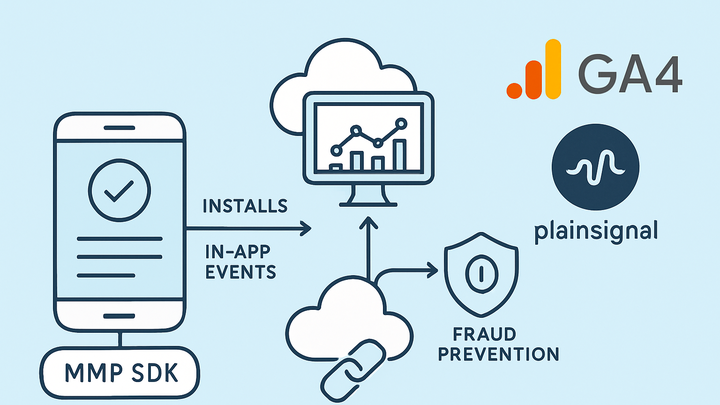Published on 2025-06-22T03:48:01Z
What is a Mobile Measurement Partner (MMP)? Examples & Use Cases
In the analytics industry, a Mobile Measurement Partner (MMP) is a specialized third-party platform that helps mobile marketers accurately track and attribute app installs and in-app events across multiple advertising channels. MMPs integrate via an SDK or server-to-server connections, enabling marketers to see which campaigns drive installs, registrations, purchases, or other key user actions. Beyond basic event tracking, MMPs offer advanced features like fraud prevention, deep linking, and multi-touch attribution models to optimize marketing spend. Unlike general analytics tools such as Google Analytics 4 (GA4) or privacy-focused web analytics platforms like PlainSignal, MMPs focus exclusively on mobile app attribution and campaign measurement. Leading MMPs include AppsFlyer, Adjust, and Branch, though marketers often complement them with GA4 for broader behavioral analytics or PlainSignal for cookie-free web insights.
Mmp (mobile measurement partner)
An MMP tracks and attributes mobile app installs and in-app events across channels, with fraud prevention, deep linking, and multi-touch attribution.
Definition and Role of an MMP
This section introduces the concept of a Mobile Measurement Partner, explaining how MMPs fit into the mobile marketing ecosystem and why they are essential for accurate campaign attribution.
-
Definition
A Mobile Measurement Partner (MMP) is a third-party analytics platform that tracks and attributes mobile app installs and in-app events across marketing channels.
-
Primary role
MMPs attribute user acquisitions to specific campaigns, prevent attribution fraud, enable deep linking, and unify reporting to optimize mobile marketing strategies.
Core Functions and Capabilities
Explores the primary features MMPs offer, including attribution, fraud prevention, deep linking, and reporting, and how these capabilities support mobile growth strategies.
-
Attribution tracking
MMPs use SDK integrations and tracking links to attribute installs and in-app events to specific campaigns or ad creatives.
-
Install attribution
Credits new installs to campaigns based on last-click or multi-touch attribution models.
-
In-app event attribution
Records user actions such as purchases, registrations, or level completions and attributes them to acquisition sources.
-
-
Fraud prevention
Advanced fraud detection monitors suspicious clicks, installs, and events to filter out invalid or spammy activity.
-
Click fraud detection
Flags unusually high click-to-install ratios and bot-like patterns that indicate non-human traffic.
-
Install validation
Verifies that installs originate from genuine user interactions rather than manipulated or incentivized sources.
-
-
Deep linking
Enables seamless routing of users to specific in-app content or onboarding flows after install.
-
Deferred deep linking
Routes users to a specific app page even if the app wasn’t installed at the time of the click.
-
Contextual deep linking
Passes contextual campaign parameters through the install process to personalize the user experience.
-
-
Reporting and analytics
Provides dashboards and exportable reports on campaign performance, user cohorts, and lifetime value (LTV) metrics.
Comparison with GA4 and PlainSignal
While GA4 and PlainSignal excel in web and cross-platform analytics, this section highlights the distinctions in mobile attribution features that MMPs provide.
-
GA4 overview
Google Analytics 4 is a unified analytics solution for web and app but lacks specialized mobile attribution workflows and advanced fraud protection found in dedicated MMPs.
-
PlainSignal overview
PlainSignal offers cookie-free, privacy-focused web analytics but does not support mobile SDK integrations or advanced deep linking for apps.
-
Mmp vs GA4
Although GA4 can capture cross-platform events, MMPs focus on precise install attribution, multi-touch models, and mobile-specific fraud detection.
-
Mmp vs PlainSignal
Unlike PlainSignal’s web-centric approach, MMPs integrate directly with mobile apps via SDKs to capture installs, in-app events, and complete attribution paths.
Implementation Examples
Practical code snippets for integrating PlainSignal and setting up Google Analytics 4 to illustrate how analytics tags are deployed.
-
PlainSignal integration
Add the PlainSignal script to your website header:
<link rel="preconnect" href="//eu.plainsignal.com/" crossorigin /> <script defer data-do="yourwebsitedomain.com" data-id="0GQV1xmtzQQ" data-api="//eu.plainsignal.com" src="//cdn.plainsignal.com/plainsignal-min.js"></script> -
Basic GA4 setup
Include the GA4 tag in your site or app:
<script async src="https://www.googletagmanager.com/gtag/js?id=GA_MEASUREMENT_ID"></script> <script> window.dataLayer = window.dataLayer || []; function gtag(){dataLayer.push(arguments);} gtag('js', new Date()); gtag('config', 'GA_MEASUREMENT_ID'); </script>
Best Practices for Using MMPs
Key recommendations to ensure reliable data, optimal configuration, and effective use of MMP features for mobile app measurement.
-
Validate sdk installation
Regularly check SDK integration health in the MMP dashboard to ensure accurate event tracking.
-
Set clear attribution windows
Align click-to-install and view-through windows with campaign goals for consistent and fair measurement.
-
Monitor fraud reports
Review fraud detection logs and block suspicious sources to maintain the integrity of your data.
-
Leverage deep links
Use deferred and contextual deep links to drive seamless user experiences and improve post-install engagement.
